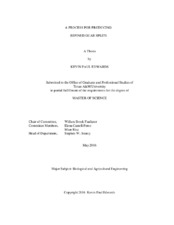| dc.description.abstract | Guar (Cyamopsis tetragonoloba) is a warm-season, annual, leguminous crop that was introduced to the United States in 1903. Guar is harvested with a combine at which time seed pods and leaves are removed. Seeds are processed after harvesting to obtain refined guar splits. A primary use for guar is the production of guar (galactomannon) gum from the refined splits. Guar seed processing equipment primarily originates in India, where the crop has been grown for many years. The purpose of this research is to develop a scalable system for producing refined guar splits that will reach a minimum viscosity of 6500 cP at a 0.92% solids concentration and a white color. Two pilot scale process streams including heating, milling, sieving, and polishing were developed to produce refined splits.
The target viscosity of 6500 cP was achieved under certain conditions for both processes. A white color was not achieved, however predictive models were developed to determine the effects of experimental factors on color and viscosity response variables. Impurities in refined split samples greatly decrease viscosity of the final solution. Thoroughly cleaning and polishing splits is critical to achieving a consistently high viscosity.
Quality metrics vary by end user and affect process parameters. Increasing polishing time increased viscosity but with lower yields of polished splits. Increasing heating temperature had some desirable effects on viscosity and color, but extra costs will be associated with higher energy demands. Raw bean color appeared to affect the color of the refined splits. Darker splits are not as desired by end users and are often purchased from processors at discounted rates. Gum content is not affected by darkening of the seed coat. However, darker color is not as desired by industries where aesthetics is a concern, such as food and pharmaceuticals. Darkening of seed coats can be reduced during the growing and reproducing of the crop. In addition, alternative polishing technologies can be considered to improve yield and efficiency. | en |


